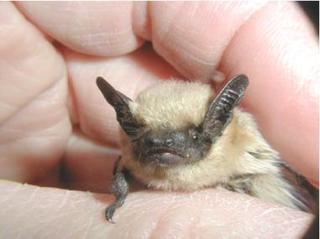
Western pipistrelle
Order : Chiroptera
Family : Vespertilionidae
Subfamily : Vespertilioninae
Species : Pipistrellus hesperus
The Western pipistrelle is listed as Least Concern (LR/lc), lowest risk. Does not qualify for a more at risk category. Widespread and abundant taxa are included in this category, on the IUCN Red List of Threatened Species
Facts about the western pipistrelle
Pipistrellus hesperus is usually the first species to emerge to feed in the late afternoon, before dusk (crepuscular), but they also may be encountere d late in the evening (ca.
The western pipistrelle, Pipistrellus hesperus, is an exceedingly small bat found throughout Utah in deserts and rocky habitats, often near water. (Full text)
Pipistrellus hesperus is the smallest of all North American bats, and can be distinguished from the small Myotis species (californicus and ciliolabrum) by (Full text)
) The Western Pipistrelle (Pipistrellus hesperus) is the smallest bat in the United States, with a wingspread of 190-215 (Full text)
The little western pipistrelle bat (Pipistrellus hesperus) is another desert species. (Full text)
No photograph available Body length: 1 1/2 - 1 3/4" Diet: Small insects The western pipistrelle is the smallest bat in the United States, and it is small indeed: Adults weigh
Tuttle, BCI / 854-6101 The western pipistrelle is strikingly marked with a black face mask that contrasts with its silky straw-gold fur.
Western Pipistrelle Pipistrellus hesperusHabitat: The western pipistrelle is one of the more common bats in canyon and desert country of the southwestern United States (Barbour and Davis 1969). (Full text)
In Idaho, the western pipistrelle is found in Gem, Nez Perce, Twin Falls and likely other western counties. (Full text)
Western Pipistrelle ClassOrderFamilySpecies Mammalia Chiroptera Vespertilionidae Pipistrellus hesperus Western Pipistrelle Distribution, Abundance, and Seasonality The western pipistrelle is a common to abundant resident of deserts and arid grasslands and woodlands. (Full text)
Pipistrellus hesperus Description: The western pipistrelle is the smallest of Colorado's bats.
1990: Western pipistrelle is found in the Maxwell National Wildlife Refuge (Maxwell National Wildlife Refuge, 1990) *28*.
Duke DISTRIBUTION, ABUNDANCE, AND SEASONALITY The western pipistrelle is a common to abundant resident of deserts and arid grasslands and woodlands.
Western pipistrelles are among the first bats to emerge in the evening.
Life History: Western pipistrelles are often the first bats captured in an evening in mist nets set (Full text)
Western pipistrelles are known to hibernate during cold weather, but individuals do become sporadically active during the winter months. (Full text)
1995: Western pipistrelles are residents of the Lincoln National Forest (USFS, 1995) *54*.
Western Pipistrelles are the smallest bat species found in the U.
“Pips”-the tiny Western Pipistrelles-are also found in the Cave, but seem to come no further (Full text)
"Western pipistrelles are the ones most people see, because they come out early in the evening, and they have an eye-catching fluttery way of flying," says Mary Wenzel, a Goleta resident who has taken more than a passing interest in the flying mammals.
Western Pipistrelles are by far one of the smallest bats in the United States weighing in anywhere from 3-6 grams.
More animals beginning with W
